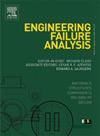Fluid-solid coupling large deformation failure analysis of bucket foundations in saturated clay
IF 4.4
2区 工程技术
Q1 ENGINEERING, MECHANICAL
引用次数: 0
Abstract
The suction bucket foundation, utilized as the structural foundation for offshore wind turbines, generates pore pressure accumulation and reduces effective stress and eventually leads to failure through fluid–solid coupling during installation. To accurately predict changes in the load-bearing capacity of the suction bucket foundation during installation, a numerical simulation method for large deformation in fluid–structure coupling of saturated clay is proposed. The approach utilizes ABAQUS with its secondary development module, integrating the RTISS calculation method, the modified Cambridge soil model, and Biot consolidation theory. The accuracy of the RITSS large deformation finite element method for analyzing the penetration problems in saturated clay was validated through simulations of the cone penetration test (CPT). A numerical model was developed to analyze fluid–solid coupling in the suction bucket foundation during penetration and to assess the bearing capacity stability throughout installation. The results indicate that the normalized penetration resistance of a bucket foundation in Malaysian kaolin clay is 6.53. Within the initial 10 days, excess pore water pressure at the base of the bucket foundation decreased by 28 %, with the coefficient (Tc50) for 50 % maximum pore pressure dissipation time measured at 0.022. The proposed numerical simulation method for pore pressure dissipation was validated, providing valuable insights into addressing fluid–solid coupling in large deformation simulations of saturated cohesive soil.
饱和粘土中桶形基础流固耦合大变形破坏分析
吸力桶基础作为海上风力发电机组的结构基础,在安装过程中通过流固耦合产生孔压积累,降低有效应力,最终导致失效。为准确预测吸力桶基础在安装过程中承载能力的变化,提出了饱和粘土流固耦合大变形的数值模拟方法。该方法利用ABAQUS及其二次开发模块,结合RTISS计算方法、修正的剑桥土模型和Biot固结理论。通过锥形侵彻试验(CPT)仿真,验证了RITSS大变形有限元法分析饱和黏土侵彻问题的准确性。建立了吸力桶基础侵彻过程中流固耦合的数值模型,并对整个侵彻过程中的承载力稳定性进行了评估。结果表明:马来西亚高岭土中桶形基础的归一化贯入阻力为6.53;初始10 d内,桶形基础底部超孔隙水压力降低28%,50%最大孔压消散时间的系数Tc50为0.022。本文提出的孔压耗散数值模拟方法得到了验证,为解决饱和黏性土大变形模拟中的流固耦合问题提供了有价值的见解。
本文章由计算机程序翻译,如有差异,请以英文原文为准。
求助全文
约1分钟内获得全文
求助全文
来源期刊

Engineering Failure Analysis
工程技术-材料科学:表征与测试
CiteScore
7.70
自引率
20.00%
发文量
956
审稿时长
47 days
期刊介绍:
Engineering Failure Analysis publishes research papers describing the analysis of engineering failures and related studies.
Papers relating to the structure, properties and behaviour of engineering materials are encouraged, particularly those which also involve the detailed application of materials parameters to problems in engineering structures, components and design. In addition to the area of materials engineering, the interacting fields of mechanical, manufacturing, aeronautical, civil, chemical, corrosion and design engineering are considered relevant. Activity should be directed at analysing engineering failures and carrying out research to help reduce the incidences of failures and to extend the operating horizons of engineering materials.
Emphasis is placed on the mechanical properties of materials and their behaviour when influenced by structure, process and environment. Metallic, polymeric, ceramic and natural materials are all included and the application of these materials to real engineering situations should be emphasised. The use of a case-study based approach is also encouraged.
Engineering Failure Analysis provides essential reference material and critical feedback into the design process thereby contributing to the prevention of engineering failures in the future. All submissions will be subject to peer review from leading experts in the field.
 求助内容:
求助内容: 应助结果提醒方式:
应助结果提醒方式:


